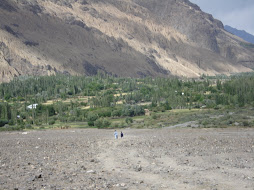Garages and huts are being converted into well-equipped dispensaries run by dedicated locals up north, writes Maureen Lines
Shidi is a wild desolate place, stretching from Gaihiret to Drosh, in the area of Chitral; it is the site of an ancient graveyard and scene of many ambushes. It is a barren area, having few fields which are farmed by Gujas, a semi nomadic people. Although the main road on the other bank of the river provides communication to the towns, on the Shidi side, only a dusty, empty track, running through deserted Afghan refugee camps, gives access to the rare jeep traveller.
Amidst the few corn fields and derelict stone houses is a lock up garage, which has been turned into a dispensary. At fifteen, Shafi, who uses his father’s garage in their summer fields, is quite young to be a dispenser. He is however, excellent in English and is studying to go to university.
The garage is fitted with shelves, bearing medicine bought with funds from the Australian High Commission. The Gujas have dark complexion and their features are different from the local Muslims. Few are educated and they often live in remote areas. These are the people who always fall through the net when it comes to development, either by the government or NGOs.
In the late spring some of them migrate to Nuristan, where the women are often engaged in cheese making while their husbands work as shepherds, or to mountain areas other than the Kalash, as these are forbidden to women who are considered impure in Kalash religion.
Shafi’s elder brother, Ibid, mans a dispensary at Bini Nisar, a small village a few kilometres up river near the entrance to the Kalash valley of Birir. Here the people are locals and better off than the Gujars, but they are still on the ‘wrong’ side of the river and far from any hospital or doctor.
To convert this garage on the jeep track took some doing. A glass front was put in behind the metal gates and shelves fitted. Ibid enjoys his work, even though, it requires a long walk along the jeep track, hugging the cliff above the Chitral river.
From Gaihiret, where both he and Shafi live, they have to cross the suspension bridge built by the British between 1912 and 1927. It is the highest suspension bridge in South East Asia, has a span of 300 feet and is a remarkable feat of engineering.
From Bini Nisar, a jeep track goes to the Kalash valley of Birir. Here the Kalasha people and the Muslims live side by side. Most of them are subsistence farmers. A few own shops, some drive jeeps while others are involved in timber cutting which was illegal in the past. At the moment, a good DFO and forest guards are controlling the cutting, and most of the wood leaving the valleys is dead wood, both for firewood and construction purposes.
A few men work on the road crew, a tiring, dusty and particularly hard job during the summer months. It is a long way to Chitral to see a doctor. Not everyone can afford the journey into town or the doctors’ fees, on top of which is the cost of medicine.
Shamsa Rehman is another dispenser. Back in the days before 9/11, he was a tourist guide. Now married, with two children, he tries to supplement his meagre salary with income he derives from a small grocery shop.
The dispensary is on the edge of the Kalash dancing ground, but its construction is not yet complete. So far it has taken five years with money from the Finns, a small percentage from fund raising activities in Islamabad and from private funds.
The other day, I checked the register as I do on a regular basis. As I picked up the heavy ledger, I was again astounded at how many entries there were. In the three hours in the morning, when the dispensary is operative, nearly 40 people come for medicines. Many of them are sent by the government dispenser, who has never, in the 28 years I have known him, ever had any medicine in his unit.
The register at Shaikhonondai, Rumbur, is also impressive with something like 3,500 entries in the two and a half years it has been open. This dispensary is run by Inayatullah, a young Nuristani. His father is suffering from bone TB and the free medicines provided by the government have had no effect. So he has to take over a thousand rupees from his Rs2,000 salary per month, to keep his father alive.
Shaikhonondai, village of Shaikhs (the converted ones) is the most northerly of all the villages in the Kalash valleys. This is the most remote of the non-government dispensaries. It is only a day’s ride to the Ganglewat Pass into Nuristan, Afghanistan. In 1895, those not wishing to be converted to Islam, escaped from the forced conversion of Abdul Rehman, by fleeing to British territory across the Durand Line. These Nuristanis, who live above eight thousand feet, do farming, keep goats in the high pastures and trade with their countrymen across the border.
It is a two-hour trek down valley to the nearest Kalash village of Balanguru. In winter the track is often impassable with 15 feet snow drifts. Here a bottle of Calpol means the difference between life and death to a child suffering from a fever.
In Balanguru, Daud, a Kalash man, also a former tourist guide, runs the dispensary. Being the only son, it is his duty to also farm his aging parents’ land.
Such circumstances, made worse by an acute ear infection, leading to an operation and some loss of hearing, have prevented Daud, a bright student, from studying at university.
Whatever dreams he may have had, his wife and children and parents keep him very busy. Whenever we meet, he always has a warm cheerful smile.
Converted garages, small shops, and one in the midst of being built (a small garden is also being planned) with able and dedicated dispensers, provide a service which has alleviated suffering and saved many lives.-Dawn
Thursday, October 30, 2008
Subscribe to:
Post Comments (Atom)
Awesome and rugged

Beauty of Chitral

Kishmanja, a beautiful village in Yarkhun valley
Lush green

DIZG: threatened by floods

The legendary village of Ayun in Chitral

On way to Bumburet
Dizg, Yarkhun

Blog Archive
-
▼
2008
(195)
-
▼
October
(50)
- Sit-in staged against delay in Sheshi power house ...
- Govt warned against price hike
- Postgraduate college still a pipe dream in Chitral
- Severe food crisis may hit Chitral
- SELF HELP: Life On The Wrong Side
- Chitral seminar calls for protection of women's ri...
- Education, developmet in Chitral
- Aga Khan's visit still not confirmed
- Chitral: the secrets of my peace!
- Brep: power house project hits snags
- CM okays uplift projects for Chitral
- Work on Yarkhun bridge begins
- NBF readers' club scheme coming to Chitral
- Met official killed in Chitral
- Eliminating women trafficking our collective respo...
- Face of man accused of women trafficking blackened...
- Drosh residents protest power outages
- Rumi’s thoughts can bring stability to world
- Aga Khan's visit to Chitral - Letter 2
- Aga Khan's visit to Chitral -Letter 1
- Lowari tunnel opening to be a gigantic step, says NHA
- Arrangements for Lowari festival reviewed
- Widow's allegations denied
- Proposed Lowari tunnel festival - Letter
- Multi-stakeholder forum - Letter
- Arrangements for Lowari tunnel festival discussed
- Aga Khan to visit Chitral in mid-November?
- Body on women's rights formed in Chitral
- US drones fly over Chitral?
- Five cases of violence against women in Chitral in...
- Bids for trophy hunting invited
- Over 3,000 Benazir income support cards distribute...
- Preparations to welcome Aga Khan in full swing in ...
- Anti-polio drive begins in Chitral
- NHA agrees to open Lowari tunnel in winter
- MNA justifies supporting PPP
- Timely completion of uplift projects ordered
- Impersonator arrested
- Opening of Lowari tunnel for light traffic demanded
- Shortage of technical staff mars uplift in Chitral
- Bajaur blockade to hurt Chitralis too
- Upper Chitral residents to pay bills locally
- Chitral colleges lack hostel facilities
- Over 75,000 children to be administered polio drops
- Trade corridor: paradigm shift we’ve been waiting ...
- Lowari tunnel will be opened this winter
- Woman commits suicide in awi
- Islamabad-Chitral flights still being mismanaged
- JI leader sees conspiracy to establish Ismaili state
- Most Chitralis unable to go home on Eid due to hig...
-
▼
October
(50)
About Me

- Zar Alam Khan Razakhel
- Village Dizg, Yarkhun valley, Chitral, Pakistan
- I blog at http://chitraltoday.net (ChitralToday) about Chitral, its people, culture, traditions and issues. I have been writing about Chitral since 2000. Chitral is a scenic valley in the extreme north-west of Pakistan.
No comments:
Post a Comment